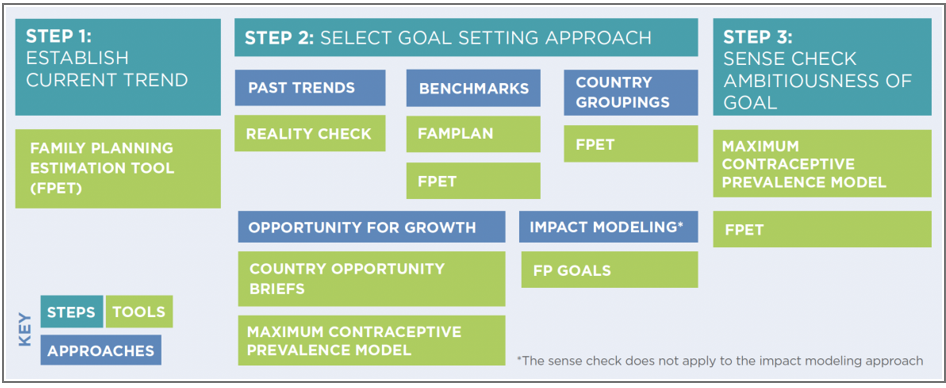The most common topline goal shared across countries is Modern Contraceptive Prevalence (mCPR), which is easy to track across time and can be looked at in relation to contribution of specific contraceptive methods. While mCPR is a clear measurement goal, landing on the right number for an effective goal can be tricky. A right-sized goal is an important aspect of accountability; setting a goal too low or too high may impact motivation and limit the ability to hold the government accountable. An ambitious but achievable goal will generate momentum and political will, focus efforts, and serve as a benchmark for measuring progress. Different country contexts require different approaches to goal setting including starting level of mCPR, current growth in contraceptive use, and political commitment to family planning.
Featured below are several approaches countries can take to set a reasonable mCPR goal. Resources with more detailed information on the approaches and tools that can support right-sized goal setting appear at the bottom of the page.
Past trends: a goal may be set based on observed historical trends in a country, which are extrapolated to a target level at some point in the future. The years used to create the trend vary, but oftentimes the trend between the last two national surveys is used. The target may be to maintain the trend as projected or adjust the trend upward.
Benchmarks: a goal may be set based on a benchmark with wide consensus. A two-point annual percentage point growth rate is often used as a benchmark for mCPR goals, as this is widely considered fast growth. Another benchmark example is to double the mCPR growth rate.
Country groupings: a goal may be set based on the average performance of similar countries. For example, countries can be grouped according to where they sit along the S-curve pattern of mCPR growth or can be grouped regionally. Goals may then be set based on the highest growth rate in the group.
Opportunity for growth: a goal may be set based on identified opportunities for mCPR growth, for example meeting the contraceptive needs of youth or postpartum women. This approach is often used when national priorities have already been set or data analysis shows that focus on a specific intervention or sub-set of women presents an opportunity for substantial growth in mCPR.
Impact modeling: the FP Goals model enables countries (or sub-national areas) to create scenarios that include implementation and scale-up of high impact practices (family planning interventions that have been shown to increase contraceptive use and are documented in the literature). Different scenarios can be built selecting different interventions and different levels of coverage, which are then translated into an estimated change in mCPR. In addition to setting an mCPR goal, the model also sets corresponding coverage goals for each selected intervention.
There are several steps involved in setting a right-sized goal. The first step is to establish the current trend in mCPR. The second step is to decide and use one of the presented approaches, taking into consideration your country context and the circumstances of your goal setting. You can see in the table below that there is at least one tool for each approach. The third step is to do a sense check on the level of ambitiousness in the goal.
There are a variety of tools available to help at each stage of goal setting. Tool descriptions and links follow.

Family Planning Estimation Tool (FPET)
The Family Planning Estimation Tool (FPET) is a web application that uses all available survey data to produce annual estimates for key family planning indicators, such as contraceptive prevalence and unmet need for family planning.
Reality Check
Reality Check is a tool developed by EngenderHealth that generates data for evidence-based family planning advocacy and strategic planning by examining the relationship between contraceptive prevalence rate (CPR) and population to estimate the resources required to achieve a future goal and the potential impact of achieving that goal.
FamPlan
FamPlan projects family planning requirements needed to reach national goals for addressing unmet need or achieving desired fertility. It can be used to set realistic goals, to plan for the service expansion required to meet program objectives, and to evaluate alternative methods of achieving goals.
Projecting Injectable Use Model
The Projecting Subcutaneous and Self-Injectable Use Model is a web-based tool that estimates the number of potential subcutaneous injectable (SC) and self-injectable (SI) users annually through 2030 for FP2020 countries.
Country Opportunity Briefs
Track20 Country Opportunity Briefs bring together a wide range of data sources to explore potential opportunities for family planning, considering areas related to demand for contraception, availability and access to services, quality and equity, and the enabling environment.
FPGoals
FP Goals combines demographic data, family planning program information, and evidence of the effectiveness of diverse interventions to help decision-makers set realistic goals and prioritize investments across different family planning interventions.
Maximum Contraceptive Prevalence Model
The Maximum CPR Model allows policy makers, family planning advocates, and individuals to determine a country's highest potential contraceptive prevalence rate (CPR), both in terms of use for spacing and for limiting, based on an ideal number of children and key demographic life events.
The first 2 resources below will provide you with an overview of goal setting approaches and tools, while the rest will provide more in-depth information and instruction.